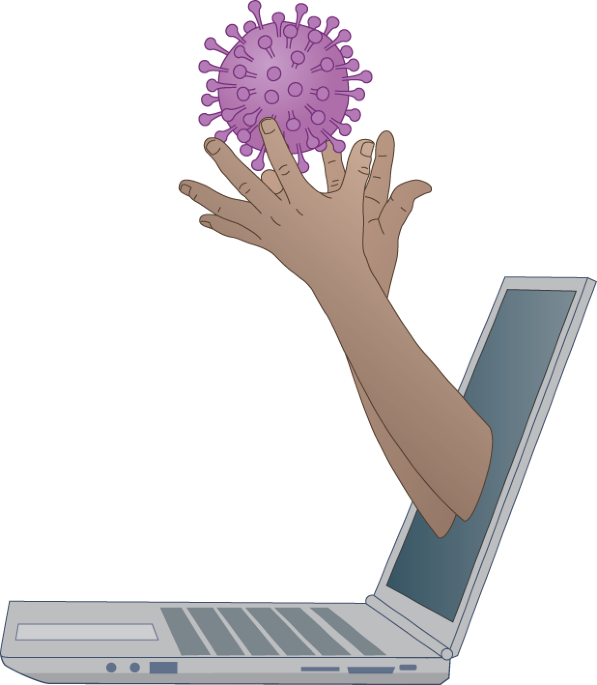Play all audios:
This month’s Under the Lens discusses a few of the growing number of recent molecular simulation studies that have made substantial contributions towards our mechanistic understanding of the
spike protein of SARS-CoV-2. Antibody development to SARS-CoV-2, the causative agent of COVID-19, has largely revolved around the viral spike (S) glycoprotein, which mediates host cell
entry by binding to a cell surface receptor, angiotensin-converting enzyme 2 (ACE2). The S protein is a trimeric class I fusion protein, in which each monomer is composed of two subunits: S1
and S2. The receptor-binding domain (RBD), where interaction with ACE2 occurs, is located within subunit S1. Proteolytic cleavage at the S1–S2 site exposes the S2 site, liberating the
fusion peptide and initiating the process of infection. The details of the conformations, orientations and dynamics of the many glycans that decorate the surface of the S protein are not
attainable from structural studies. Molecular dynamics is a computational technique that enables prediction of the time evolution of molecular systems. The resolution of the system can vary;
an all-atom system would explicitly include all of the atoms, whereas coarse-grained systems combine some atoms together into pseudo atoms. Classical mechanics is then used to propagate the
motion of the molecules. For the S protein, the structure of the protein is taken from X-ray crystallography and/or cryo-electron microscopy data. The glycans are then modelled in, and if
the full-length protein is being studied, the transmembrane domain is embedded into a model membrane. Many days of simulations of such systems will typically yield trajectories that
represent microseconds of molecular motion. Credit: Philip Patenall/Springer Nature Limited In a recent study, Amaro and co-workers1 were able to identify a unique functional role of the
_N_-linked glycans at sites neighbouring the RBD by modulating the conformational dynamics of the S protein and its impact on ACE2 binding. This was achieved through all-atom simulations of
the glycosylated, full-length S protein on timescales of multiple microseconds. The extended simulations also enabled characterization of the vulnerabilities of the entire glycan shield of
the S protein, which may inform future development of vaccines and antiviral agents. In subsequent work, a team lead by Amaro and Chong used a weighted ensemble approach to perform molecular
dynamic simulations of the S protein head, in a study that revealed that a specific glycan along with three charged residues facilitate opening of the RBD, required for binding to ACE2
(ref.2). In both studies, the predictions from simulations were corroborated by experimental studies. More recently, a detailed molecular dynamics simulation study of the S protein glycans
by Fadda and co-workers3 has shown that the nature of the glycosylation at key sites impacts the stability of the RBD in the open state. Furthermore, they were able to provide a
molecular-level interpretation for increased infectivity corresponding to a recent loss of glycosylation from a key site owing to viral evolution. These predictions were experimentally
validated in later work. Details of the flexibility within the stalk region of the S protein were revealed by large all-atom simulations performed by Hummer and co-workers4. Four
glycosylated S proteins anchored into a patch of viral membrane were simulated in a system containing more than four million atoms. The results showed three distinct hinge regions, which
provide the head region of the protein with substantial orientational flexibility. The authors speculated that the conformational freedom provided by the hinges may interfere with antibodies
gaining access to the stalk region as well as facilitate engagement of the S protein with host membranes. Although for a system of such a large size, and as highlighted by the authors
themselves, the simulations (2.5 microseconds) may not have sampled all of the conformational space, there was good agreement with cryo-electron tomography data. In all of the cases
described here, the S protein has been simulated with its glycans, for multiple microseconds, taking input from multiple sources of experimental data to set up the simulations to reveal key
details with a fundamental and likely therapeutic impact. In doing so, the authors have shown that molecular dynamics simulations are an indispensable tool for mechanistic studies of
viruses, and with availability of growing computational power and the advent of enhanced sampling methods, their contributions to this field will continue to grow. REFERENCES * Casalino, L.
et al. Beyond shielding: the roles of glycans in the SARS-CoV-2 spike protein. _ACS Cent. Sci._ 6, 1722–1734 (2020). Article CAS Google Scholar * Sztain, T. et al. A glycan gate controls
opening of the SARS-CoV-2 spike protein. _Nat. Chem._ 13, 963–968 (2021). Article CAS Google Scholar * Harbison, A. M. et al. Fine-tuning the spike: role of the nature and topology of the
glycan shield in the structure and dynamics of the SARS-CoV-2 S. _Chem. Sci._ 13, 386–395 (2022). Article CAS Google Scholar * Turonˇová, B. et al. In situ structural analysis of
SARS-CoV-2 spike reveals flexibility mediated by three hinges. _Science_ 370, 203–208 (2020). Article Google Scholar Download references AUTHOR INFORMATION AUTHORS AND AFFILIATIONS *
Department of Biochemistry, University of Oxford, Oxford, UK Conrado Pedebos & Syma Khalid Authors * Conrado Pedebos View author publications You can also search for this author inPubMed
Google Scholar * Syma Khalid View author publications You can also search for this author inPubMed Google Scholar CORRESPONDING AUTHORS Correspondence to Conrado Pedebos or Syma Khalid.
ETHICS DECLARATIONS COMPETING INTERESTS The authors declare no competing interests. RIGHTS AND PERMISSIONS Reprints and permissions ABOUT THIS ARTICLE CITE THIS ARTICLE Pedebos, C., Khalid,
S. Simulations of the spike: molecular dynamics and SARS-CoV-2. _Nat Rev Microbiol_ 20, 192 (2022). https://doi.org/10.1038/s41579-022-00699-9 Download citation * Published: 04 February 2022
* Issue Date: April 2022 * DOI: https://doi.org/10.1038/s41579-022-00699-9 SHARE THIS ARTICLE Anyone you share the following link with will be able to read this content: Get shareable link
Sorry, a shareable link is not currently available for this article. Copy to clipboard Provided by the Springer Nature SharedIt content-sharing initiative

